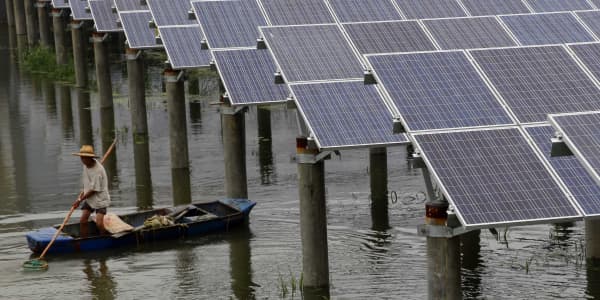Forget Beijing and Shanghai, businesses seeking to expand in China are looking at second and third tier cities to take advantage of booming consumption and infrastructure opportunities.
New analysis from the Economist Intelligence Unit (EIU) has found the mainland's most promising cities, based on growth indicators such as changes in gross domestic product, population, and income.
Several of the cities on this list were little known five years ago, but investment and innovative policy approaches, have put them firmly on the map.
Inland cities dominated, taking 18 of the top 20 growth hotspots, instead of the traditionally strong eastern provinces.
"At the regional level, cities from central Chinese provinces perform the strongest. They are benefitting from industrial relocation and improved transport infrastructure. In contrast, north-eastern cities are struggling, grappling with unfavorable demographics and structural economic weaknesses," the EIU said.
Click ahead to see China's 10 most promising cities.
—By Nyshka Chandran. Posted on July 24, 2015
#10: Chengdu
The provincial capital of western Sichuan province, Chengdu, has emerged as a favorite among foreign investors in recent years thanks to its geographical position, with access to the wider south-western market.
The city's mayor has taken it upon himself to bring in a slew of Fortune 500 companies to boost job creation and increase wages and several technology companies, such as Intel, Dell and Texas Instruments, have already set up shop.
#9: Zhengzhou
Located in the Yellow River Valley, widely referred to as the cradle of Chinese civilization, Zhengzhou, the former capital of the Shang Dynasty, has transformed into an industrial city of nine million.
Merchandise exports in this high-density zone grow at a compound annual rate of 53 percent, the second highest on the EIU's index.
#8: Zhuzhou
The prefecture-level city of Zhuzhou is part of the ChangZhuTan Golden Triangle, a major economic development zone in Hunan province, and was one of the first to embrace heavy industry once the People's Republic of China was founded in 1949.
Heavy reliance on machine and chemical manufacturing in previous decades made Zhuzhou one of the country's ten most polluted towns, but officials are hoping that a new focus on services will help transform the city's image.
#7: Huaibei
One of China's most important energy bases, Huaibei, was built on the Xiangshan Mountain in the Anhui province and boasts more than 35 billion tons of perspective coal reserves, according to the Anhui government.
Home to Huaibei Mining, one of China's largest coal companies, the city is also a key player in the regional transport network, with railways connecting to northern and eastern provinces.
#6: Huainan
Also located in Anhui's resource-rich landscape, Huainan has been ramping up efforts to diversify from energy production to manufacturing.
"The export boom in Huainan has been based on equipment manufacturing, textiles and consumer electronics-products that in the past may have been produced in the neighboring coastal provinces," the EIU said.
#5: Suqian
The city of Suqian is expected to record China's highest metropolitan population increase, growing at a 3.2 percent compound annual rate until 2019, according to the EIU.
While it remains underdeveloped compared with its heavily urbanized peers in the Jiangsu province, a growing consumer market makes it an attractive bet. Consumer spending per head is growing around 8.4 percent, the EIU said.
#4: Chongqing
One of the few names remaining from the EIU's last ranking five years ago, the western municipality of Chongqing has an especially bullish outlook.
"Although the Western Development Strategy favored by the government in the 2000s has petered out, President Xi Jinping's One Belt, One Road plan to boost regional connectivity will benefit western cities with transport links to neighboring countries," the report said.
A high-speed rail link with onward connections to Central Asia and Europe is also due to be completed in the coming years, alongside southward links to Southeast Asia.
#3: Hengyang
Known as the "Bright Pearl in Southern China," Hengyang is the second-largest city in Hunan province.
It recorded the second-fastest rate of investment growth nationwide between 2008 and 2013, and those funds were used to enhance its technological transformation, especially for light-emitting diode (LED) manufacturing, the EIU noted.
Taiwanese electronics contract manufacturer Foxconn has been a major player in that regard, with the construction of an industrial park.
#2: Xiangyang
"Endowed with locational advantages, a solid labor pool, relatively good infrastructure and strategic government support, the second-largest city in Hubei province has become more appealing to investors," the EIU said.
Xiangyang has also built an industrial park to attract businesses relocating from the southern manufacturing powerhouse of Shenzhen.
Plans are underway to deepen connections with external markets; the city is set to replace Chongqing as the starting point for the Yuxinou railway, a freight line that connects China with Europe via Central Asia.
#1: Guiyang
Topping the overall rankings, as well as the economic output category specifically, Guiyang is the capital city of Guizhou, China's poorest province in terms of GDP per head.
Guiyang has positioned itself as a leading "big data" center, according to the EIU, with major state-owned telecommunications giants and private players such as Alibaba all investing in in the city.
"Guiyang may turn out to be a surprising success story, rather than another fabled ghost city," the EIU remarked, noting that it also has one of the lowest urbanization rates in the country at an estimated 38 percent last year.




